When onboarding a new B2B client on paid social, aligning on goals and expectations is a central part of our discovery process. Often, we find that our new partners have targets that start and end with “as many leads as possible at the lowest cost.”
After taking stock of their ad accounts, we generally see several campaigns with little to no delineation between audiences that are all working towards the same goal — capturing as much lead volume as possible. Sometimes, this works! But inevitably, we hear a lot of the same frustrations:
- Our CPLs are on the rise
- We’re not seeing the same volume we once did
- We try to invest more in a given platform, but our efficiency tanks
Though it may seem logical to focus ad spend solely on the campaigns driving the desired outcome, this can impact an account’s ability to scale long-term. Too often, a narrow-minded and conversion-focused approach to lead generation ignores the importance of top-funnel prospecting.
With this in mind, we’ve begun implementing full-funnel marketing strategies across paid social platforms for our B2B clients. Now, with nearly two years worth of data across multiple client accounts, we’re breaking down a tried-and-true strategic framework for campaigns and sharing our findings.
Demand Generation vs. Lead Generation
First, some context. For marketing teams, lead generation is typically the end goal of B2B campaigns. Before a Sales Qualified Lead can become an opportunity and eventually a customer, they’re a good-old fashioned MQL.
Marketers often prioritize lead generation is often prioritized without weighing the benefit of demand generation — a concept that aligns more closely with the full-funnel approach.
According to Gartner, demand generation is a marketing strategy focused on building reliable brand awareness and interest, resulting in high-quality leads.
Clients are often focused on the bottom-funnel campaigns that drive these leads, particularly when budgets are tight. This is typically the case for paid social campaigns. Clients are generally more apt to invest a large proportion of their ad spend into channels that drive last touch conversion, like search.
In reality, a multi-channel investment is a perfect scenario for implementing a demand generation strategy that speaks to users in different stages of the funnel. Utilizing these tactics on paid social platforms can lead to:
- A lift in branded search
- An increase in assisted conversion volume
- High intent, high-quality leads
Driving Results
Over the past two years, we’ve proven the impact of these tactics across many B2B accounts, from mid-size to enterprise level. Here’s an example of the full-funnel strategy we implemented for a client that skyrocketed growth.
We began managing paid social advertising for a tech startup in March 2021. Growth had stalled due to a lack of top-funnel acquisition, and the previous team had tested in to Facebook with little success.
Thankfully, this client had a wealth of content available which allowed us to begin crafting a true awareness campaign to prospect for new customers. Over the first three months of the engagement, we launched awareness campaigns on LinkedIn, Twitter, and Facebook. We restructured the existing remarketing campaigns on LinkedIn into a mid- and bottom-funnel touchpoint and replicated those efforts on Facebook.
By December of that year, we had seen a 408% increase in lead volume on LinkedIn compared to the previous year. With a steady stream of new users entering our retargeting pools, we more than tripled ad spend by the end of 2021, all while decreasing our average CPL by more than $30.
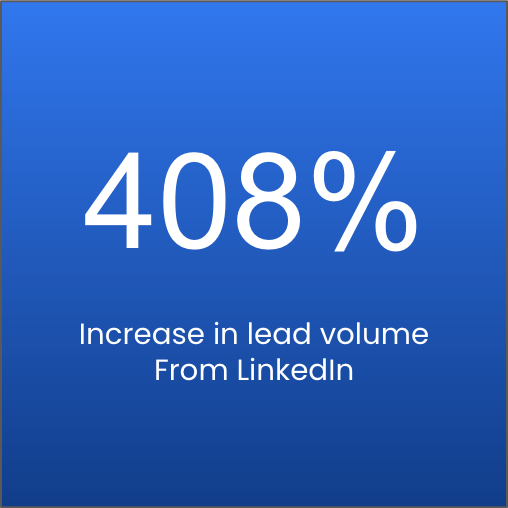 | 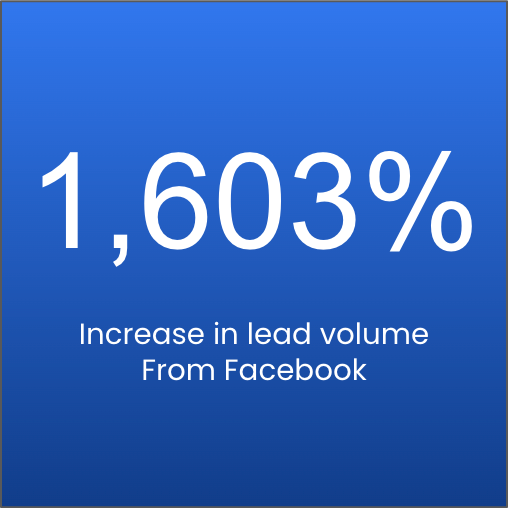 | 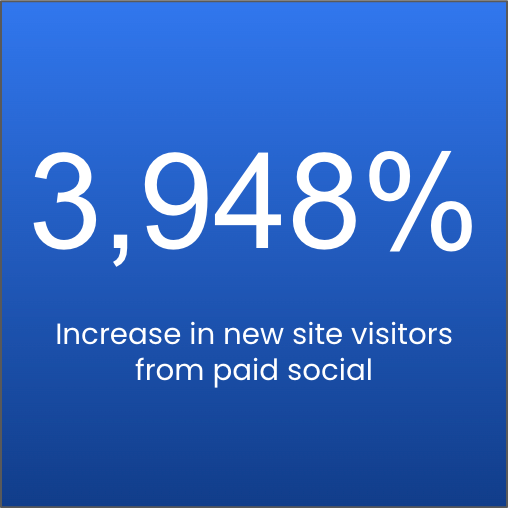 |
With a dedicated full-funnel strategy on Facebook, we drove a 1,603% increase in lead volume and improve acquisition costs by more than $100 year over year. Focusing on demand generation helped us drive over 206,600 new users to the site from paid social campaigns — a 3,948% increase from the previous year.
So, how did we get there?
What Does a Full-Funnel B2B Strategy Look Like?
While there are special considerations for B2B accounts, the primary goal of a full-funnel strategy is an engaging, relevant user experience. Before we dig into tactics, consider brushing up on your knowledge of the general full-funnel approach.
Top of Funnel
While often overlooked, awareness campaigns are perhaps the biggest success factor for long-term account health. Without new prospects filling the marketing funnel, remarketing audiences will be exhausted over time. This can directly impact an account’s ability to scale and drive results.
Targeting
Focus on reaching engaged users by utilizing Lookalike audiences modeled off of key-page visitors. On LinkedIn, our team has uncovered compelling audience insights by tapping into Member Group targeting and leaning on Job Function rather than specific title names to avoid unintentionally excluding relevant users.
Ad Experience
These are the campaigns to lean on video and GIF assets — anything to drive engagement with the audience. These ad formats drive higher click-through rates, and video viewership can be a strong signal for retargeting.
Don’t utilize CTAs and landing page destinations on conversion. Instead, surface content that focuses on familiarizing new users with the brand and its offerings, like:
- Blog posts
- Product FAQs
- Thought leadership content
- Informational webinars
Salesforce nails a true top-of-funnel ad with an engaging and informative video that isn’t afraid to play into questions about their product and mission.
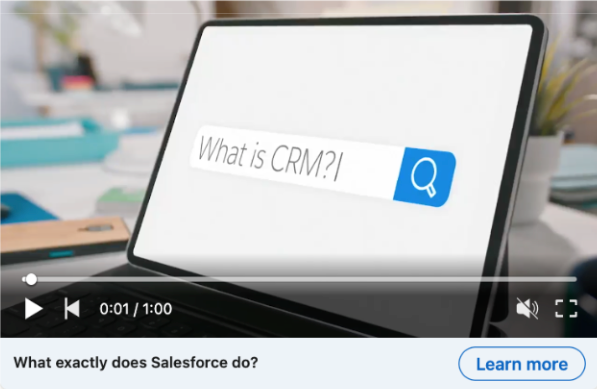
Middle of Funnel
Begin to create demand by nurturing prospects that have shown intent based on their engagement with top-funnel content.
Targeting
- Utilize engagement-based retargeting signals like percentage of video viewed or time on site
- Create remarketing segments based on users that visited the pages utilized in awareness campaigns
Ad Experience
LinkedIn and Facebook offer a native lead ad format, which allows advertisers to gate content users can download after submitting a form. This opens up the opportunity to share various assets that differentiate the brand, build trust with users, and help solidify a prospective customer’s decision.
Utilize high-value content like:
- Comparison guides
- Whitepapers
- Case studies
Here, Zoom takes advantage of the lead ad experience by gating a downloadable report. The use of Gartner branding can help build trust by association.
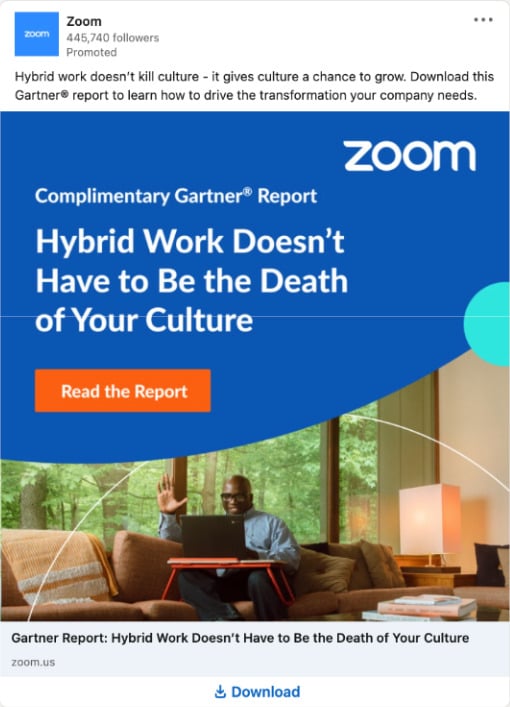
Bottom of Funnel
Move engaged prospects even further down the funnel to capture the most qualified lead possible.
Targeting
- Layer in additional remarketing segments that capture the users that downloaded a piece of content at the mid-funnel stage
- Explore testing opportunities by building segments made up of users that opened a lead form but did not submit
Ad Experience
Depending on the type of destination page, in-platform lead forms can help drive lower-cost action among users at the bottom of the funnel. If you’re pointing to a landing page on a website, make sure that page is optimized for conversion.
Focus on driving action by pointing users to content like:
- Contact forms
- Trial sign-ups
- Schedule a meeting or consultation
- Demo requests
Work OS monday.com appeals to authority by featuring a review from a senior decision-maker before prompting a user to sign up for a demo via a native lead form.
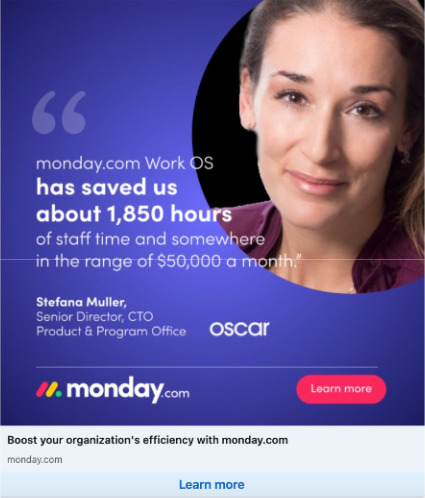
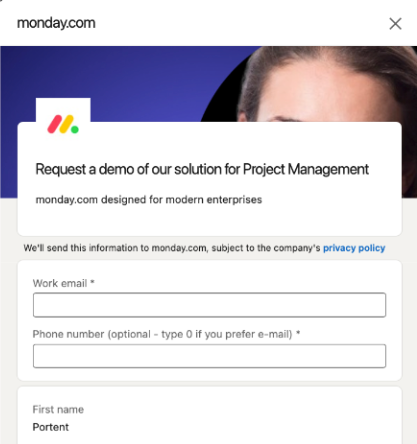
Conclusion
Our performance over time for our clients is a testament to a strategic investment in the entire user journey. While it may mean an initial divestment away from the very campaigns that drive leads, a full-funnel strategy is the key to long-term account health and scalability.









